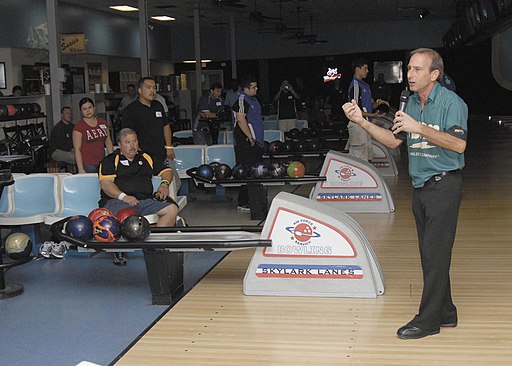Those who have a dream of becoming a professional bowler typically have quite a few questions about the process.
Our article on going pro will answer quite a few of them, and today’s piece will cover another important part of the puzzle: how much you can expect to make if you are successful in your pro bowling quest.
How Do Pro Bowlers Make Money?
The main way that bowling pros make money is by earning prize money in tournaments.
While that fact is straightforward enough, it’s important to understand how the tournaments work and how much money is at stake.
The Professional Bowling Tour (PBA) of the United States is the premier tour in the sport. There are some tours in other countries (like Japan’s Professional Bowling Association known as JPBA) but top pros from all over the world aspire to join the PBA.
Most people will think of the main pro tour that gets shown on TV, but there are also others for different groups of bowlers including juniors and those who are 50+. There are also various PBA Regional Tours which also hold tournaments in particular parts of the country.
For the main tour, most of the events are open to the whole PBA membership, and it is even possible to compete in a variety of tournaments as a non-member assuming that you meet all qualifications (including a minimum average). Read over the PBA frequently asked questions for more detail on this.
How Much Do You Make On Tour? For Winning a Pro Tournament?
Now that you know the basics of how professional tournament play works, let’s add some real numbers to it.
First, in recent years, top professional bowlers have averaged a salary of $200,000 to $300,000. The average salary for all professionals, however, is much lower.
With any occupation, it’s important to differentiate between the highest earners who typically have a lot more experience, and those who are newer to the job and likely make much less in comparison.
With bowling, one source estimates that the average pro bowling salary is 25% of the top bowlers, which would come out to roughly $60,000 given the above numbers. The employment website Zip Recruiter, on the other hand, gives a lower average bowling salary of $42,450 per year.
What about the prize pools for winning tournaments? The biggest events can provide huge paydays. For example, the season opening PBA Players Championship in 2021 featured a $1,000,000 prize fund, including $250,000 for first place and $130,000 for second place.
In contrast, a 2021 event on one of the PBA Regional tours (in this case the PBA IL Valley Super Bowl Midwest Open) has a prize pool including $2,500 (projected) for first place, $940 for 4th, and down to $600 for 12th.
At the end of the day, money earned directly from competition is far from the only way bowlers make money. In order to get their salary to a respectable level, other sources are necessary.
Many bowlers make a lot of their total compensation from endorsements and sponsorships for gear like bowling balls and accessories. Many pros also earn money from running clinics and bowling coaching for aspiring bowlers of all ages.
Finally, more well-known professionals can also earn from bowling exhibitions and other types of public or private appearances.
Why Are Bowling Salaries So Low Today?
In the 1960s and 70s, things were much different for bowlers. During this time period known as the “golden age” of bowling, top pros “made twice as much money as NFL stars, signed million dollar contracts, and were heralded as international celebrities” (Rise and Fall). A bowler, in fact, was the first person to ever get a sponsorship deal worth $1 million (Don Carter in 1964).
For PBA earnings leaders, the 1970s were the best decade as salaries were $446,710 (adjusted for inflation) which is much greater than current earnings. In subsequent decades, however, the top salaries trended down significantly. Today’s top bowling salaries pale in comparison to the lowest of the low in just about any other professional sport. So what caused this sharp decrease?
One major factor is sponsorships, and the PBA has lost some of its major sponsors from back when the league was much more mainstream in popularity. Television coverage is also less than it used to be now that there is much more competition for eyeballs. The days of bowling tournaments being regularly shown on network stations like ABC have come to an end. Finally, advances in bowling materials have made high scoring much more attainable for more bowlers, which reduces the allure of bowling as a spectator sport for some viewers.
Future Outlook for Bowling Salaries
For the situation to turn around and for bowling salaries to increase in coming years, a few things would have to happen.
First, the PBA would need to continue building popularity among the newer generations which would then increase sponsorship revenue as well as the value of the TV rights. The recent influx of new streaming services interested in acquiring a broad lineup of sports could add healthy competition to the landscape and result in better deals for bowling.
Also, in the social media age, having more exciting bowling personalities who generate a huge following on Instagram or other networks would be a good thing for the tour. After all, Americans regularly list bowling as their favorite recreational sport in surveys and a huge percentage report visiting a bowling center at least once a year. Bowling is especially popular among children so converting them into lifelong fans of the sport would do wonders for starting to get bowling salaries back to a higher level. It’s unlikely we’ll ever see a repeat of the “golden years” of the 60s and 70s, but there’s still plenty of room to go up and help make the game a more attractive proposition for more aspiring professionals.
Additional Sources
“The Rise and Fall of Professional Bowling,” Priceonomics



Leave a Reply